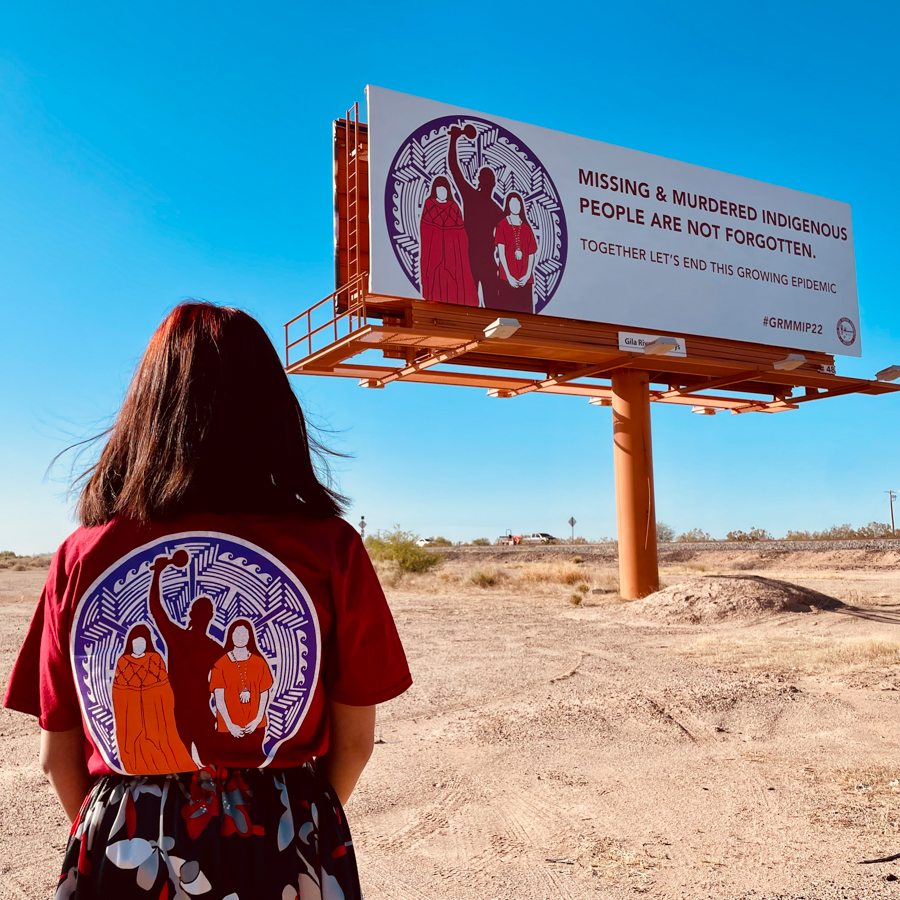May 5 Marked First Anniversary Recognizing Missing and Murdered Indigenous People
May 06, 2022
Emma Hughes
Gila River Indian News
May 5 marked the first anniversary of two important milestones: The Gila River Indian Community in 2021, proclaimed it as Missing and Murdered Indigenous People (MMIP) Awareness Day in an executive order signed by Gov. Stephen Roe Lewis and Lt. Gov. Monica Antone, and President Joe Biden last May also designated the date as National Missing and Murdered Indigenous Persons Awareness Day.
Several cases involving missing indigenous people are unreported throughout the U.S. and state and homicides rates are not recorded. MMIP Awareness Day recognizes “the injustice to the victims and their families,” Lt. Gov. Antone said, “We have been very involved, tribally, state-wide and at all federal levels.”
As of 2016, more than 5,700 Indigenous women and girls were reported missing and only 14 of those cases were logged with the Department of Justice, according to the National Crime Information Center.
The murder rate for Indigenous women is 10 times higher than the national average with indigenous women making up a significant portion of missing and murdered individuals, according to a study by the Center for Disease Control and Prevention.
Initially known as the Missing and Murdered Indigenous Women and Girls (MMIWG) movement to shed light and awareness on the longstanding crisis of violence against Indigenous women and girls, more awareness is being brought to the overall violence against Indigenous people. In the U.S. alone, 85 percent of American Indian and Alaska Native women and 81 percent of American Indian and Alaska Native men will experience violence—higher than any other demographic, according to the National Institute of Justice.
In 2019, GRIC created the Missing and Murdered Indigenous Peoples/Persons Response Team and began work in the Community with the Executive Office, Office of General Counsel, Office of the Prosecutor, Gila River Police Department, Tribal Social Services and Protective Services.
Later, Human Resources, the Communications & Public Affairs Office, Gila River Health Care – BHS and SANE, and Gila River Gaming Enterprises were also added.
The Gila River Police Department also established a cold case unit in collaboration with their violent crimes and homicide unit which identified over 74 cases from 1997 to present. So far, 18 of those cases have been closed, according to GRPD Chief of Police, Timothy Chavez.
“We are one of very few tribal agencies throughout the country to have developed our own cold case unit,” said Chief Chavez.
GRPD has made a silent witness number available at (520) 562-7144. Anyone with any information is encouraged to call, “if you see something, say something”, is their motto and all calls remain anonymous.
To improve the cold case unit, GRPD has added a K9 unit and began working with the Bureau of Indian Affairs and the state’s universities who teach and provide technical assistance with investigations.
Additionally, in 2019, state rep. Jennifer Jermaine (White Earth Ojibwe) sponsored the passing of HB2570 which led to the creation of the state’s Study Committee on Missing and Murdered Indigenous Women and Girls (MMIWG).
MMIWG study committee determines how the state can reduce and end the violence against Indigenous women and girls, establishes methods for tracking and collecting data on violence against Indigenous women and girls, reviews policies and practices, and identifies any barriers to state resources in tracking and reducing violence against Indigenous women and girls.
Lt. Gov. Antone and Chief Chavez were appointed to serve on the State’s Study Committee for MMIWG which featured 23 members, which released a statewide study report, in partnership with Arizona State University School of Criminology and Criminal Justice in 2020.
• 160 Native American women and girls in the state were known to be missing from 1976-2018 and data shows the trend continued in 2019 and 2020, according to the FBI’s Supplemental Homicide Report and Just for Native women data.
•Native American women and girls of all ages are missing and murdered, ranging from infants to elders. Women are missing for almost twice as long as men, who average 12 years and while women average 21 years.
•Indigenous Peoples go missing across the state with the most in Maricopa and Navajo counties.
•Counties in Arizona that have higher populations such as Maricopa and Pima, have more Indigenous female homicides compared to counties with smaller populations.
•Most Native American women and girls were killed in urban cities of Phoenix, Mesa, and Scottsdale followed by rural areas. Women from 20-40 years old are at a higher risk of being killed.
•Majority of murders involved firearms followed by knives and other weapons.
The Committee examined the problem through multidisciplinary and multi- jurisdictional lenses to identify the issues leading to cold cases, to missed opportunities to act quickly and rescue people, and to systematic problems with access to victim services, as stated in the final report.
Many families and victims faced jurisdiction issues, lack of support and resources, no data in law enforcement database, and financial impacts were also addressed.
Crime Victim Compensation is available to cover cost for medical, funeral, crime scene clean-up, counseling, and transportation for victims and families.
May 5, Missing and Murdered Indigenous People Awareness Day Events:
The Gila River Indian Community encouraged everyone to wear red on May 5 as a symbol of support, hope and acknowledgment and a virtual two-mile walk/run was held for Missing and Murdered Indigenous People Awareness Day.
Specially designed t-shirts were given to Community members who registered, designed by GRIC member Jaime Jackson. Participants are encouraged to share their journey and photos with social media with the hashtag #GRMMIP22 or email Special.Events@gric.nsn.us.
At the state capitol, an MMIP Awareness Day event “Silent No More”, was held and featured educational workshops on the state’s existing and new laws on MMIP/victimization, youth leadership and MMIP awareness, advocacy for families and more.
Informational booths, event speakers and a memorial walk was also held followed by the lighting of the capitol.

